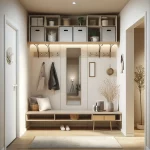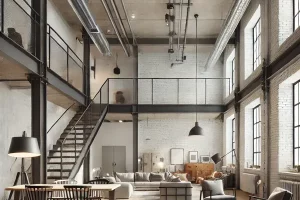How to build s deep winter greenhouse: Welcome to the world of Deep Winter Greenhouses (DWGs)! A DWG is like a warm, cozy house for plants when it’s chilly outside.
It lets us grow yummy veggies and pretty flowers all year long, even when snow is falling. It’s like having a little piece of summer, even in the cold winter months.
Understanding Deep Winter Greenhouses
Deep Winter Greenhouses (DWGs) are a special kind of greenhouse for growing plants even when it’s very cold outside. Let’s understand what they are, how they are different from usual greenhouses, and why they are good for farming in a green way.
What is a DWG?
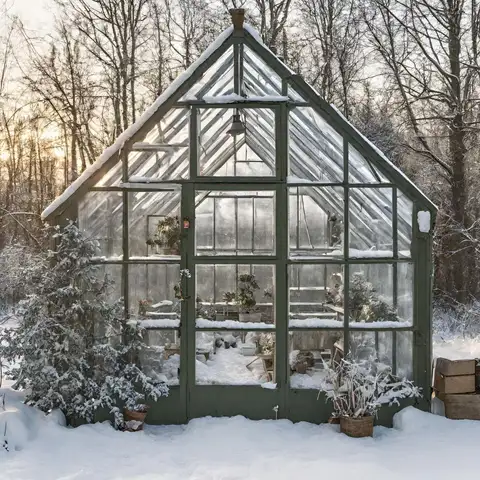
A Deep Winter Greenhouse (DWG) is a cozy home for plants in winter. It catches sunlight to keep warm. The sun shines through a big glass wall and warms the inside. At night, the warmth stays inside to keep plants happy.
How is a DWG different from usual greenhouses?
Catching Sunlight:
DWGs love sunlight! They catch a lot of sun to keep warm. Usual greenhouses might need heaters to stay warm, but not DWGs!
Special Design:
DWGs have a big glass wall that leans towards the sun. This design is like a sun-catcher. Usually, greenhouses have straight walls and may not catch as much sun.
Keeping Warm:
DWGs have smart ways to keep warm. They might have barrels of water that catch and keep warmth. Usually, greenhouses might need extra heaters to do this.
Saving Money:
In the long run, DWGs can save money because they don’t need much extra heat. Usual greenhouses might have higher bills because of heating costs.
Why are DWGs good for green farming?
Saving Energy:
DWGs use the sun’s energy, which is free and clean. It is good for our planet.
Growing All Year:
DWGs let us grow food even when it’s snowing outside. It is great for having fresh local food all year round.
Lower Costs:
With less need for extra heat, DWGs can save money. It is good for farmers and gardeners.
Teaching About Green Living:
DWGs teach people about green ways to grow food. They show how we can use the sun to grow food, even in winter.
Helping Communities:
By growing food all year, DWGs help make sure everyone has fresh food to eat, even when it’s cold.
Deep Winter Greenhouse Design
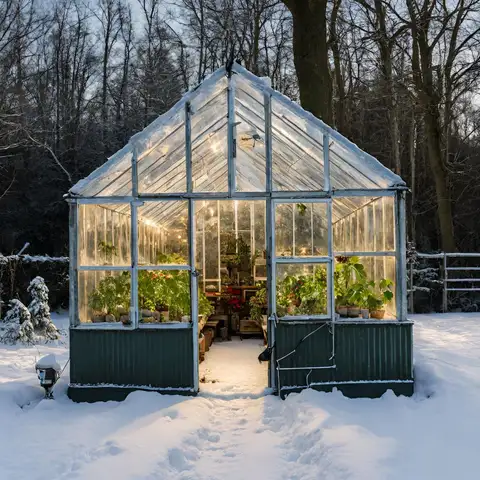
When winter comes with its chilly days, how do we keep our green buddies warm and happy? A Deep Winter Greenhouse (DWG) is the answer! It’s like a cozy home for plants, even when snow is all around.
The design of a DWG is like its recipe. It tells us how to make it warm and welcoming for plants using the sun’s warmth, good insulation, and fresh air. Let’s dive into how we can make this happen!
Key Design Principles for a Successful DWG:
Facing the Sun:
- Pointing your DWG towards the south helps catch lots of sunshine.
- Clear materials like polycarbonate on the roof let the sun’s rays in while keeping the cold out.
Warm Foundation:
- A well-wrapped foundation keeps the warmth from escaping into the ground.
Storing Warmth:
- Things like water barrels or stones inside can soak up the sun’s warmth and give it back when it’s cold.
The Magic of Passive Solar Heating:
Passive solar heating is about catching the sun’s warm hugs and keeping them for later.
Catching Sunlight:
- A sloping roof is like a sun catcher, grabbing more sunshine during winter.
Keeping the Warmth:
- Materials that store warmth help keep the greenhouse cozy during chilly nights.
Keeping It Warm and Breezy:
Insulation:
- Wrapping the sides and bottom of the DWG keeps the cold out.
- Using two layers of clear material or special foam boards helps keep more warmth inside.
Fresh Air for Plants:
- Plants need fresh air, and having vents lets the old air out and new air in.
- Vents on the roof or sides let warm, moist air out and bring fresh air in.
How to Build A Deep Winter Greenhouse
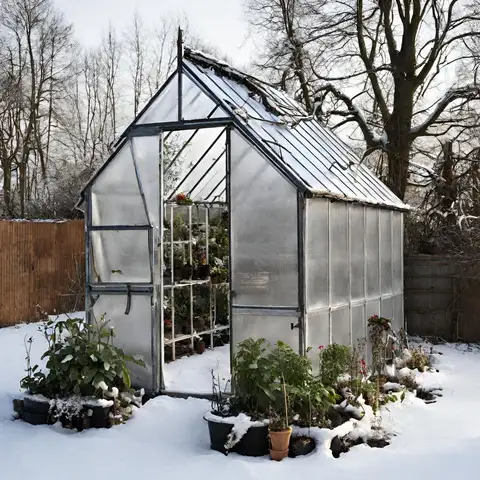
A Deep Winter Greenhouse (DWG) is not just a shelter but a thriving environment for your plants. Let’s unfold the blueprint to building your very own deep winter greenhouse, where every sunbeam counts, and every leaf stays green.
Choosing the Right Location: Orientation and Solar Access
- Face the Sun: Position your DWG to face south. This way, it catches the most sunlight, especially in winter when the sun is lower in the sky.
- Avoid Shadows: Keep away from buildings or trees that can block the sun. Every beam of sunlight is precious warmth for your plants.
Material Selection for Resilience and Energy Efficiency
- See-through Roof: Materials like polycarbonate or clear plastic let the sunshine in while keeping the cold out.
- Insulated Walls: Insulated walls are like cozy blankets, keeping the warmth inside.
- Sturdy Frame: A strong frame stands firm against winter storms. Choose durable materials like treated wood or metal.
Constructing the Structure: Walls, Roof, and Glazing
- Strong Foundation: Start with a solid foundation to keep your DWG steady and warm.
- Sloping Roof: A roof that slopes towards the sun catches more sunlight, warming your greenhouse.
- Double Glazing: Two layers of clear material trap more warmth inside.
Ventilation and Temperature Control Systems
- Let It Breathe: Vents let fresh air in and old air out. They also help excess warmth escape on sunny days.
- Keep It Warm: On cold nights, close the vents to keep the warmth in. Use insulation and heat-storing materials like water barrels to maintain a cozy temperature.
- Automatic Controls: Consider using automatic vent openers and fans to manage temperature and airflow.
Deep Winter Greenhouse Plans
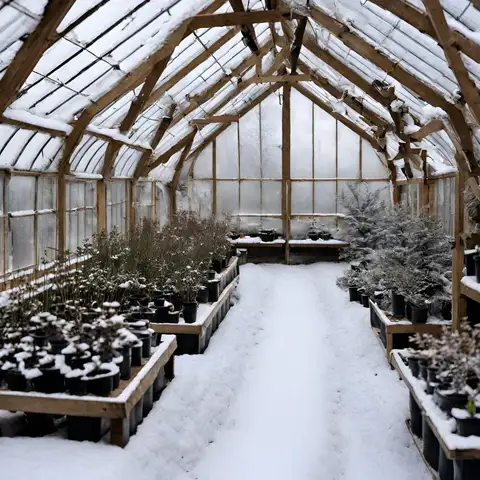
Building a Deep Winter Greenhouse (DWG) is a fun way to keep gardening even when it’s cold. Let’s look at how you can plan your own DWG that fits your space, budget, and gardening dreams.
Getting to Know DWG Plans:
- Basic Plans: These are simple, easy-to-follow plans that cover the main parts of a DWG, like the sunny side glass, warm walls, and good airflow.
- Changed-Up Plans: Sometimes, gardeners change the basic plans a bit to make them work better for their own space.
Making Plans Work for You:
- Size Choices: The size of your DWG depends on how much space you have. There are small plans for small spaces and big plans for big spaces.
- Money Matters: Some plans cost more than others. If you have less money to spend, look for simple designs and materials that don’t cost much. If you have more money, you might want to check out plans with cool features like automatic windows.
- Your Style: Your DWG can look the way you want it to. There are many different styles to choose from, like a cute little garden house or a modern, sleek design.
Finding Good DWG Plans:
- Online Booking: You can find many DWG plans online. Some are free, and some you have to pay for.
- Gardening Friends: Talking to other gardeners can help. They might share their plans with you or tell you where to find good ones.
- Schools and Farming Groups: Places like the University of Minnesota have lots of information and plans for DWGs.
- Professional Help: You can also ask a professional to help you make a plan. They can give you a plan that has everything you need.
DIY Deep Winter Greenhouse
Building a Deep Winter Greenhouse (DWG) doesn’t have to be hard or costly. With some basic tools, materials, and a good plan, you can have your own green space in winter. Here’s a simple step-by-step guide to help you on your DIY DWG journey.
Step-by-Step Guide:
Plan Well:
- Pick a design that you like and fits your space.
- Make a list of all the materials and tools you will need.
Get Your Tools and Materials:
- Basic tools like a hammer, saw, drill, and screws are a must.
- For materials, you will need things like wood for the frame, polycarbonate or another glazing for the sunny side, and insulation for the cold sides.
Start with a Strong Base:
- Make sure your base is level and strong. It is what holds your DWG up, so it’s very important.
Build the Frame:
- Follow your plan to build the frame of your DWG. Make sure it’s square and sturdy.
Put on the Glazing:
- The glazing is what lets the sunshine in to warm your DWG. Install it on the sunny side of your DWG.
Insulate Well:
- Insulation keeps the cold out and the warm in. Insulate the north side, the roof (except the glazing), and the base.
Set Up Good Air Flow:
- Airflow keeps the air fresh for your plants. Set up vents or fans to keep the air moving.
Check Everything:
- Go over everything to make sure it’s all tight and right.
Necessary Tools and Materials:
- Tools: Hammer, saw, drill, screws, tape measure, level.
- Materials: Wood, glazing (like polycarbonate or glass), insulation, vents or fans.
Common Challenges and Tips:
- Problem: Too Cold Inside:
- Tip: Check your insulation and add more if needed. Make sure there are no gaps or cracks where cold air can get in.
- Problem: Not Enough Sun:
- Tip: Trim any trees or bushes that block the sun. Clean your glazing to let more sunshine in.
- Problem: Stale Air:
- Tip: Make sure your vents or fans are working well to keep fresh air moving through your DWG.
Deep Winter Greenhouse Kits
Building a deep winter greenhouse (DWG) from the ground up can be fun but takes a lot of time. If you want an easier way, a DWG kit could be your answer. These kits give you all the parts you need, cut to the right size, plus instructions to put it all together. Let’s look at what these kits offer, their good points bad points, and some tips on finding a good one that won’t break the bank.
What’s in a DWG Kit?
DWG kits are like big model kits for grown-ups. They come with everything you need to build your greenhouse. Each kit has a frame, an outer cover, and sometimes extra things like insulation and vents to let air in and out.
Pros and Cons of a Kit:
Pros:
- Easy to Put Together: A kit makes building easy because all the parts are ready to go.
- Saves Time: You save a lot of time because you don’t have to measure and cut wood or plastic.
- Good Quality: Kits usually have good-quality parts that last a long time.
Cons:
- Cost More: Kits can cost more than if you buy and cut your parts.
- Can’t Change Design: Kits come with a set design, so you can only make your DWG look the same.
- Rely on the Maker: You depend on the maker to give you the right parts and good instructions.
Tips to Find a Good, Budget-friendly Kit:
When you look for a DWG kit, you want to find one that’s good quality but also fits your budget. Here are some tips:
- Do Your Homework: Look for makers with good reviews and happy customers.
- Price Check: Look at different shops to find the best price for your kit.
- Right Size and Look: Make sure the kit fits your space, and you like how it looks.
Cost Analysis of a Deep Winter Greenhouse
It’s wise to have a clear understanding of the financial involvement before diving in. Whether you plan on DIY, buying a kit, or hiring professionals, each has its cost implications.
Breakdown of Costs Involved in Building a DWG:
The costs can be broadly categorized into three sections: materials, labor, and unforeseen expenses.
- Materials: This is the bulk of your expenses. It includes the cost of the frame, covering material, insulation, flooring, and the heating system.
- Labor: If you plan on hiring professionals, labor costs can add up quickly.
- Unforeseen Expenses: Unexpected costs always pop up in projects like this. It’s smart to keep a contingency budget.
Comparing Costs: DIY vs. Purchasing a Kit vs. Professional Construction:
- DIY (Do It Yourself): This can be the most cost-effective way if you are handy and have the time. You save on labor but may face challenges that could increase costs.
- Purchasing a Kit: Kits are a middle-ground solution. They are easier and faster than DIY but more expensive. However, they are generally cheaper than professional construction.
- Professional Construction: This is the most expensive route. Professionals provide expertise and take care of the project from start to finish, but you pay for that convenience.
Ways to Minimize Costs Without Compromising Quality:
- Shop Smart: Look for sales, discounts, or bulk pricing on materials.
- Recycle: Use recycled materials where possible. For instance, repurposing old windows for glazing can save a lot.
- Trade Services: If you have a skill, trade services with friends or community members to get help on your project.
- Volunteer Labor: Organize a building weekend and invite friends to help in exchange for a good meal and fun times.
- Plan Well: A well-thought-out plan can help avoid costly mistakes and do-overs.
University of Minnesota Deep Winter Greenhouse:
The University of Minnesota (UMN) has helped a lot with making Deep Winter Greenhouses (DWG) better. These greenhouses let farmers grow cool-loving plants like leafy greens even when it’s really cold outside. Here’s how UMN has helped
Design Tricks:
- UMN figured out that a big part of making a good DWG is using the sun’s heat smartly. They designed a wall made of special glass that faces the sun, catching its warm rays to heat the greenhouse, which is super helpful in winter.
Model DWG Design:
- They made two different designs for these greenhouses and shared them for anyone to use. The designs show how to build a DWG with a glass wall facing the sun, good insulation to keep the warmth in, and ways to let fresh air in and out, which helps the plants grow well even in cold weather.
Research and Tips:
- UMN did a lot of tests to see how well these greenhouses work, especially for growing leafy greens in winter. They shared tips for farmers on how to use DWGs to grow fresh food all year and make some extra money.
Helping Others:
- They also help people and groups who want to build their DWGs. Through special programs, they share knowledge and support to help folks grow food in winter in a green way.
Purchasing a Pre-Built Deep Winter Greenhouse:
Buying a Ready-Made Deep Winter Greenhouse:
Sometimes, you can buy a Deep Winter Greenhouse (DWG) that’s already made. Here’s how you can do it:
Finding a Good DWG:
- You can look online or ask local farmers where to buy a ready-made DWG. Some places sell them, and you can choose the one you like.
What to Look For:
- When buying a DWG, check if it has a good glass wall to catch the sun’s warmth. Make sure it has insulation to keep the heat in. Also, see if it has a system to let fresh air in and out.
Comparing Costs:
- Ready-made DWGs can be more expensive than building one yourself. Look at the prices of different DWGs and compare them to the cost of making one. This way, you can decide which one is better for your budget.
FAQs
What is a Deep Winter Greenhouse (DWG)?
A DWG is a type of greenhouse designed to capture and store solar energy. It makes it possible to grow plants during the harsh winter months without using a lot of extra heating.
How does a DWG work?
A DWG uses a design that lets in sunlight through a clear, south-facing wall. The sunlight warms the inside of the greenhouse, and the heat is stored in the ground or other materials inside. This heat is then released slowly, keeping the plants warm.
What can I grow in a DWG?
You can grow cold-tolerant plants like kale, spinach, and carrots. You can also grow herbs and some types of fruit, like strawberries.
How much does it cost to build a DWG?
The cost can vary a lot. It depends on the size, materials, and whether you build it yourself or buy a kit. Building it yourself can be cheaper, but buying a kit or a pre-built DWG can save time and ensure it’s built right.
Where can I buy a DWG kit or a pre-built DWG?
Several online and local stores sell DWG kits and pre-built DWGs. It’s a good idea to read reviews and talk to other DWG owners before you buy.
Can I build a DWG myself?
Yes, you can! There are plans available online, and you might also find workshops or classes near you that can help.
What are the main things to think about when planning a DWG?
You’ll want to think about the location to make sure it gets enough sun, the materials to use to make sure it’s well-insulated, and how you’ll manage ventilation and temperature control.
How can I learn more about DWGs?
The University of Minnesota has done a lot of work on DWGs and has a lot of information available. There are also books, online forums, and local gardening groups that can help.
Having a Deep Winter Greenhouse (DWG) is a big plus. It lets you grow plants all year, even when it’s very cold outside. By having a DWG, you can enjoy fresh veggies and fruits any time you want.
Building or buying a DWG is a fun project. It’s a step into a world where you can garden all year round. It’s not just good for you, but it’s also good for the earth. DWGs use the sun’s heat to keep plants warm, which is a smart way to save energy.
So, are you ready to start your DWG adventure?
It’s a smart choice for you, your plants, and our planet. With a DWG, you can have a green thumb all year long!
Resources
- https://conservancy.umn.edu/handle/11299/208728#:~:text=Deep%20Winter%20Greenhouses%20,based%20on%20horticultural%20research%20trials
- https://www.cleanenergyresourceteams.org/extend-your-growing-season-and-conserve-energy-deep-winter-greenhouse#:~:text=If%20so%2C%20then%20the%20University,captures%20heat%20from%20the%20sun



